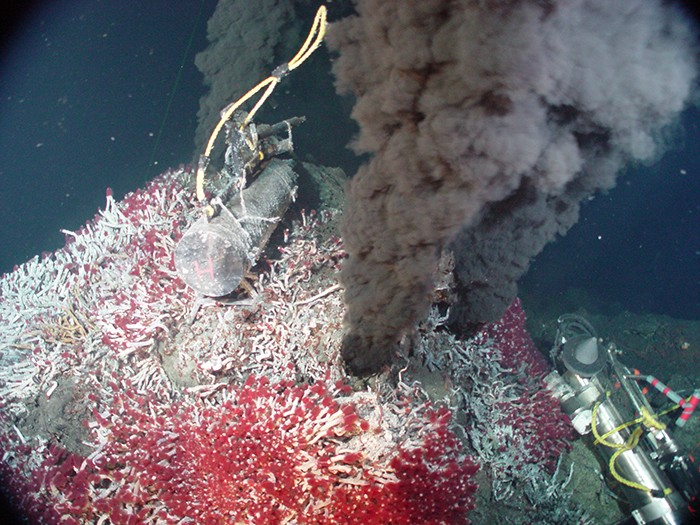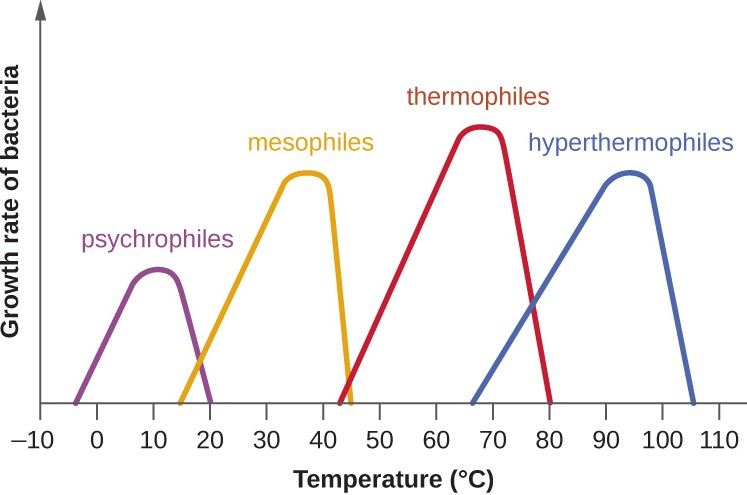7.4 Temperature and Microbial Growth
Learning Objectives
- Illustrate and briefly describe minimum, optimum, and maximum temperature requirements for growth
- Identify and describe different categories of microbes with temperature requirements for growth: psychrophile, psychrotrophs, mesophile, thermophile, hyperthermophile
Temperature and Growth
When the exploration of Lake Whillans started in Antarctica, researchers did not expect to find much life. Constant subzero temperatures and lack of obvious sources of nutrients did not seem to be conditions that would support a thriving ecosystem. To their surprise, the samples retrieved from the lake showed abundant microbial life. In a different but equally harsh setting, bacteria grow at the bottom of the ocean in sea vents (Figure 7.14), where temperatures can reach 340 °C (700 °F).
Microbes can be roughly classified according to the range of temperature at which they can grow. The growth rates are the highest at the optimum growth temperature for the organism. The lowest temperature at which the organism can survive and replicate is its minimum growth temperature. The highest temperature at which growth can occur is its maximum growth temperature. The following ranges of permissive growth temperatures are approximate only and can vary according to other environmental factors.
Organisms categorized as mesophiles (“middle loving”) are adapted to moderate temperatures, with optimal growth temperatures ranging from room temperature (about 20 °C) to about 45 °C. As would be expected from the core temperature of the human body, 37 °C (98.6 °F), normal human microbiota and pathogens (e.g., E. coli and Lactobacillus spp.) are mesophiles.
Organisms called psychrotrophs, also known as psychrotolerant, prefer cooler environments, from a high temperature of 25 °C to refrigeration temperature about 4 °C. They are found in many natural environments in temperate climates. They are also responsible for the spoilage of refrigerated food.
The organisms retrieved from arctic lakes such as Lake Whillans are considered extreme psychrophiles (cold loving). Psychrophiles are microorganisms that can grow at 0 °C and below, have an optimum growth temperature close to 15 °C, and usually do not survive at temperatures above 20 °C. They are found in permanently cold environments such as the deep waters of the oceans. Because they are active at low temperature, psychrophiles and psychrotrophs are important decomposers in cold climates.
Organisms that grow at optimum temperatures of 50 °C to a maximum of 80 °C are called thermophiles (“heat loving”). They do not multiply at room temperature. Thermophiles are widely distributed in hot springs, geothermal soils, and manmade environments such as garden compost piles where the microbes break down kitchen scraps and vegetal material. Higher up on the extreme temperature scale we find the hyperthermophiles, which are characterized by growth ranges from 80 °C to a maximum of 110 °C, with some extreme examples that survive temperatures above 121 °C, the average temperature of an autoclave. The hydrothermal vents at the bottom of the ocean are a prime example of extreme environments, with temperatures reaching an estimated 340 °C (Figure 7.14). Microbes isolated from the vents achieve optimal growth at temperatures higher than 100 °C. Some archaea grow at 105 °C and can survive autoclaving. Figure 7.15 shows the typical skewed curves of temperature-dependent growth for the categories of microorganisms we have discussed.
Life in extreme environments raises fascinating questions about the adaptation of macromolecules and metabolic processes. Very low temperatures affect cells in many ways. Membranes lose their fluidity and are damaged by ice crystal formation. Chemical reactions and diffusion slow considerably. Proteins become too rigid to catalyze reactions and may undergo denaturation. At the opposite end of the temperature spectrum, heat denatures proteins and nucleic acids. Increased fluidity impairs metabolic processes in membranes. Some of the practical applications of the destructive effects of heat on microbes are sterilization by steam, pasteurization, and incineration of inoculating loops. Proteins in psychrophiles are, in general, rich in hydrophobic residues, display an increase in flexibility, and have a lower number of secondary stabilizing bonds when compared with homologous proteins from mesophiles. Antifreeze proteins and solutes that decrease the freezing temperature of the cytoplasm are common. The lipids in the membranes tend to be unsaturated to increase fluidity. Growth rates are much slower than those encountered at moderate temperatures. Under appropriate conditions, mesophiles and even thermophiles can survive freezing.


Macromolecules in thermophiles and hyperthermophiles show some notable structural differences from what is observed in the mesophiles. The ratio of saturated to polyunsaturated lipids increases to limit the fluidity of the cell membranes. Their DNA sequences show a higher proportion of guanine–cytosine nitrogenous bases, which are held together by three hydrogen bonds in contrast to adenine and thymine, which are connected in the double helix by two hydrogen bonds. Additional secondary ionic and covalent bonds, as well as the replacement of key amino acids to stabilize folding, contribute to the resistance of proteins to denaturation.
![]()
- What temperature requirements do most bacterial human pathogens have?
- What DNA adaptation do thermophiles exhibit?

